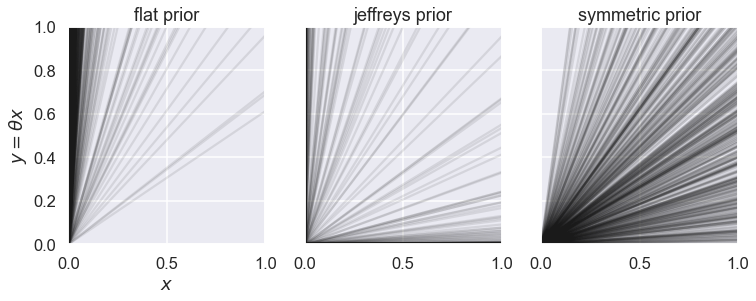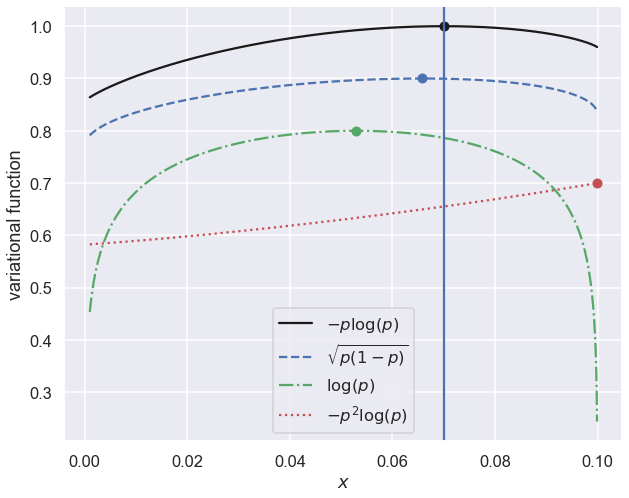8.5. Making figures for Ignorance PDF notebook¶
Last revised: 30-Sep-2019 by Christian Forssén [christian.forssen@chalmers.se]
Python/Jupyter set up¶
%matplotlib inline
import numpy as np
import scipy.stats as stats
from scipy.stats import norm, uniform
import matplotlib.pyplot as plt
import seaborn as sns
sns.set()
sns.set_context("talk")
Prior pdfs for straight line model¶
# Modules needed for Example 1
import emcee
We will define three different priors for the straight line model. Using always a flat prior U(-100,100) for the intercept, and a non-zero pdf range -100 <= slope <= 100.
def log_flat_prior(theta):
if np.all(np.abs(theta) < 100):
return 0 # log(1)
else:
return -np.inf # log(0)
def log_jeffreys_prior(theta):
if np.abs(theta[0]) < 100:
return -0.5 * np.log(theta[1] ** 2)
else:
return -np.inf # log(0)
def log_symmetric_prior(theta):
if np.abs(theta[0]) < 100:
return -1.5 * np.log(1 + theta[1] ** 2)
else:
return -np.inf # log(0)
Let us create 1000 samples from each prior pdf and plot the resulting sample of straight lines. Since the intercept is uniformly distributed in all three prior alternatives, we will just consider straight lines with intercept 0 since it makes it easier to compare the distribution of slopes.
def log_prior(th1,logp):
return logp(np.array([0,th1], dtype="object"))
ndim = 1 # number of parameters in the model
nwalkers = 10 # number of MCMC walkers
nburn = 1000 # "burn-in" period to let chains stabilize
nsteps = 10000 # number of MCMC steps to take
ncorr = 100 # just keep every ncorr sample
# we'll start at random locations within the prior volume
np.random.seed(2019)
starting_guesses = 100 * np.random.rand(nwalkers,ndim)
x = [-1,1]
fig,axs = plt.subplots(1,3, figsize=(12,4), sharex=True, sharey=True)
for ipr, logpr in enumerate([log_flat_prior,log_jeffreys_prior,log_symmetric_prior]):
np.random.seed(2019)
strprior = str(logpr).split()[1]
print(f"MCMC sampling of {strprior} using emcee with {nwalkers} walkers")
sampler = emcee.EnsembleSampler(nwalkers, ndim, log_prior, args=[logpr])
# "burn-in" period; save final positions and then reset
state = sampler.run_mcmc(starting_guesses, nburn)
sampler.reset()
# sampling period
sampler.run_mcmc(state, nsteps)
print("Mean acceptance fraction: {0:.3f} (in total {1} steps)"
.format(np.mean(sampler.acceptance_fraction),nwalkers*nsteps))
# discard burn-in points and flatten the walkers; the shape of samples is (nwalkers*nsteps, ndim)
samples = sampler.chain.reshape((-1, ndim))
# just keep every ncorr sample
samples_sparse = samples[::ncorr]
for sample in samples_sparse:
axs[ipr].plot(x,x*sample,'k',alpha=0.1)
axs[ipr].set_title(strprior.split('_')[1]+' prior')
axs[0].set_xlim([0,1]);
axs[0].set_ylim([0,1]);
axs[0].set_xlabel(r'$x$');
axs[0].set_ylabel(r'$y=\theta x$');
#fig.savefig('slope_priors.png')
MCMC sampling of log_flat_prior using emcee with 10 walkers
Mean acceptance fraction: 0.828 (in total 100000 steps)
MCMC sampling of log_jeffreys_prior using emcee with 10 walkers
Mean acceptance fraction: 0.434 (in total 100000 steps)
MCMC sampling of log_symmetric_prior using emcee with 10 walkers
Mean acceptance fraction: 0.773 (in total 100000 steps)

